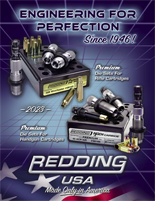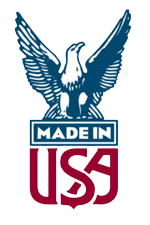Tech Line & Tips (FAQs)
Lubricating Cases
Understanding the purpose of Case Lubricant, and how it should be implemented in the reloading process, is essential for a Handloader to be successful. When used correctly, a high-quality Case Lube will prevent a host of frustrating problems and make the endeavor much easier and more enjoyable. High-quality Case Lubricants, such as Imperial Sizing Die Wax, are formulated with EP (Extreme Pressure) additives. These additives are necessary to create and maintain a sufficient barrier between the cartridge case and the Reloading Die during the compression and stress generated by the resizing process. Because EP agents are not present in ordinary oils and greases, they are not suitable for cartridge case resizing. Use of improper lubricants will result in a multitude of problems, some of which include: stuck cases, scratched cases, difficulty resizing, etc.
It is preferable that Case Lubricant is applied by hand, one case at a time. This method provides both the opportunity for thorough lube application, but also the opportunity to individually inspect each cartridge case for defects or flaws. Due to its thickness, a tremendous amount of pressure is generated at the head / web of a cartridge case during the resizing process. By comparison, the shoulder and neck are relatively thin and require less effort to resize. As you may have deduced, Case Lubricant should be applied more generously at the web than other areas of the case (see image #7 below). If the web is insufficiently lubricated, the case will become stuck in the Die. Handloaders using spray-on case lubricants need to be particularly mindful of this, especially if a loading block covers the web of the cartridge cases during application (be sure that the web is exposed, See image #6 below). If using spray-on lubricants, please follow the manufacturer’s recommendations with regard to application methods and adhesion time.
 |
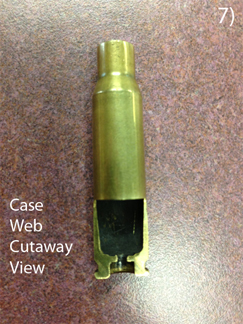 |
Please note that the inside of the case neck should be cleaned with a nylon or brass bristle brush before lubrication is applied; a few quick passes is sufficient (see image #8 below this paragraph). Cases should then be wiped free of dirt or debris but they do not need to be tumbled, ultrasonically cleaned, or otherwise polished before the resizing process. Extremely clean or highly polished cases have a higher coefficient of friction than lightly tarnished cases, making them more prone to sticking.
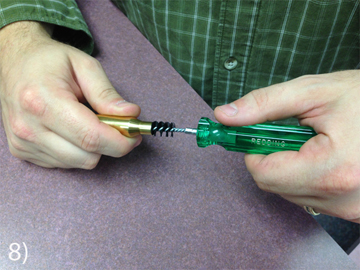 |
Though often neglected, the neck of the cartridge case should be lubricated. For this task, we recommend using Imperial Dry Neck Lube. The easiest way to apply dry neck lube is simply to dip the cartridge case neck into Imperial Application Media. The media consists of high density ceramic spheres (spheres approximate the size of #9 lead shot) that are pre-charged with Imperial Dry Neck Lube. This method allows the Handloader to lubricate both the inside and outside of the case neck simultaneously.
To apply Case Lubricant, please follow the procedure below. Please note that the steps that follow will prepare a cartridge case to be Full Length Resized. If Neck Sizing only, please skip ahead to step #6.
1) Work some Imperial Sizing Die Wax between the tip of your forefinger and thumb.
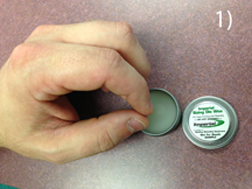 |
2) When sufficiently coated, use your index finger and thumb to hold the base of the cartridge case.
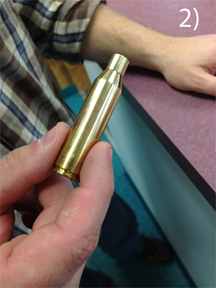 |
3) Use your free hand to grip the case’s neck and rotate it so that lubrication transfers to the cartridge case.
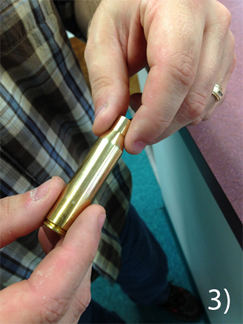 |
4) When the web area has been completely coated, slowly move toward the shoulder or case mouth, applying an even coating of case lubricant along the way. If resizing a bottleneck cartridge case, stop at the shoulder/body junction. If lubricant finds its way to the shoulder, simply wipe it away with a clean finger to avoid dents.
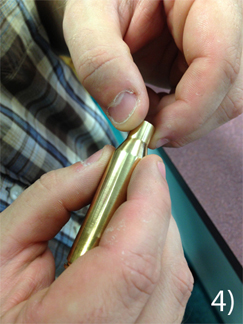 |
5) Should the lubricant become sparse, replenish by repeating step #1.
6) If resizing a bottleneck cartridge case, we recommend dipping the case neck into Imperial Application Media to lubricate the inside and outside of the case neck with dry neck lube (images 5 & 5B below).
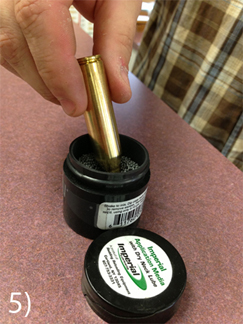 |
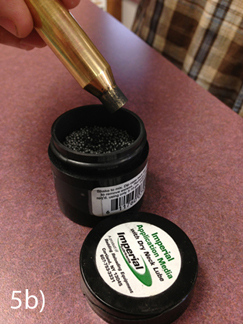 |


